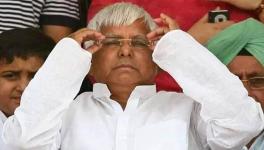Why Jharkhand Polls Are More Critical Than They Appear
Image for representational use only.Image Courtesy : NDTV
Assembly elections in Jharkhand kicked off on Saturday, amidst a sense of discontent among the Adivasis, who make up sizeable 26% of the state’s population. In one way or another, tribal groups in the state have been simmering ever since the 2014 state polls. After those elections, veteran Bharatiya Janata Party (BJP) leader Raghubar Das assumed charge as the first non-tribal chief minister of the state.
Jharkhand was carved out as a separate state in November 2000 and the prime motive was to provide focused development to the tribal groups of the region and protect their identity and natural resources. The selection of Das, who belongs to a social group classified in the Constitution as Other Backward Classes or OBC, became a reason for displeasure among tribal communities. In fact, Das is from the Rajnandgaon region of neighbouring Chhattisgarh province, which added to their angst. This dissatisfaction spilled over on the streets of the capital city Ranchi, the moment the new chief minister took charge and santhal groups staged protests and dharnas against it.
The Adivasis are a force to reckon with in Jharkhand’s electoral politics, as 28 of the state’s 81 Assembly seats are reserved for a Scheduled Tribe (ST) candidate. In 2014, the BJP won 37 of the 81 seats with its regional ally, All Jharkhand Students Union or AJSU, which won five seats that helped it cross the threshold to majority in the Assembly. Can the BJP cross 40 seats alone, is the question. The AJSU has the backing of the kurmi OBC community, making it a prominent factor in the Chota Nagpur region and around. It remains to be seen if the split BJP-AJSU will divide the Kurmi vote.
That said, arguably, it is not religion but ethnicity that dominates Jharkhand’s social sphere. Also, during Das’s five-year term, the Adivasis have found several other reasons to despair with the party ruling the state, other than the chief minister’s origins and identity. Among wide sections of tribal groups, the perception has set in that a corporate-BJP nexus is stridently depriving, displacing and marginalising them.
The reason is that in November 2016 the BJP-led coalition, which had garnered over 34% of the vote share (its own votes plus the 3.68% vote share of AJSU), amended the longstanding tenancy laws governing the state, the Chotanagpur Tenancy Act of 1908 and the Santhal Pargana Tenancy Act of 1949. Amending these laws, which were intended to largely prohibit the transfer of tribal land to non-tribal buyers and served to protect and regulate the community ownership of the land, turned out to be steps towards the de-tribalisation of the Adivasis.
In addition, even the domicile policy accentuated the de-tribalisation process. The BJP’s quest to consolidate its social base among the immigrant population manifested within a year of the carving out of the state of Jharkhand.
The Babulal Marandi government in 2001 proposed a bill to consider 1932 land records as the base to decide the issue of Adivasi and Moolvasi versus Dikus (immigrants). This law was struck down by the Ranchi High Court in 2001. Later, 1986 was taken as the base as to whosoever have been living in Jharkhand since 1986 would be treated as domicile. This demographic change added to the numerical strength of the immigrants who came to further dominate the tribes.
The BJP’s political rivals, represented by the main opposition party, the Jharkhand Mukti Morcha (JMM), followed by the Congress party and the Jharkhand Vikas Manch (JVM), drove home the point among the tribes that the BJP government is disturbing the existing legal framework to please industrialists at their expense.
Against the proposed amendments, the state governor Draupadi Murmu had received 192 protest petitions from various organisations affiliated with the tribal and environmental groups. There were massive public demonstrations by Adivasis and the bills were challenged inside the Jharkhand Legislative Assembly as well. It came to be widely acknowledged, even in the national press, that the chief minister had failed to read the pulse of tribal Jharkhand. The governor did not sign the bill into law.
But the BJP moved another amendment in the Jharkhand Assembly the same year. This was to change the centrally-legislated Land Acquisition (Jharkhand Amendment) Act. Section 10A of the amended act exempts the government from four critical responsibilities: one, developing infrastructure projects, including schools, colleges, universities, hospitals and so on; two, conducting social impact assessment during land acquisition; three, seeking consent of the affected people, and four, ensuring food security. In this way, the very purpose of enacting the Land Acquisition Act—to provide fair compensation for those who lose their land to public projects—was being defeated.
This further raised the spectre of a corporate-BJP nexus that would marginalise the interests of the tribes in the state. As a result, in the May 2017 by-polls for three seats of the Jharkhand assembly came around, the BJP lost every seat.
By 2019, the scenario has only worsened. Even the mahto tribal community, who have usually supported the BJP electorally, appear to have developed considerable mistrust against the ruling party. This unease became evident when the AJSU led by Sudesh Mahto decided to contest the state election solo in 2019, and not as part of the BJP-led National Democratic Alliance (NDA).
Jamshedpur (Tatanagar), the city of the Tatas, is in Jharkhand. Recently, it was reported, based on voluntary disclosures by the BJP to the Election Commission, that it had received Rs 473 crore or 75% of its donations from the Tata Group’s Progressive Electoral Trust. Not just the Tatas, a wide cross-section of India’s corporate sector takes a lot of interest in elections in Jharkhand. The state accounts for 40% of the country’s mineral resources. It is a thickly-forested state, providing all that an industrialist would need: Land, minerals, and water from the rivers Subarnrekha and Kharkhai. This also makes the elections for the small state of Jharkhand carry much more weight than its 81-member Assembly.
By 2017, when its efforts to amend the land-related laws were frustrated, the BJP conveniently returned to its core Hindutva agenda in the state. So, in August 2017, it introduced and passed the Anti-Conversion Bill in the state Assembly. This provides for three years imprisonment and a fine of Rs 50,000 for a violation.
Yet, the going is not all that smooth for the party. Tribal resistance to the BJP’s attempted de-tribalisation of Jharkhand’s Adivasis has lately manifested in the Pathalgadi movement. The ground for this resistance was laid when Das started promoting, in 2014 itself, the idea of a land bank. This paved the way for thousands of acres of non-cultivable land to be given away to the corporate sector. He organised a global investors’ summit, “Momentum Jharkhand” in Ranchi on 16 and 17 February, 2017, where a number of memoranda of understandings (MoUs) were signed and the government adopted land banks as a policy. In June 2019, another Momentum summit was held, when it was reported that the state’s revenue and land reform department has already acquired nearly 21 lakh acres of common land, mostly in the rural parts of the state.
The Pathalgadi movement has now arisen as a symbol of the resentment of the tribal people against this kind of policy intervention. Through it, the tribal communities are seeking to replace the power of the central and the state governments with that that of the local gram sabha or village council. On 7 December, Khunti district and neighbouring areas go to the polls, along with constituencies covering a few other districts. Many villages in this belt have erected green-painted stone slabs at their entrances, which record the provisions of the Constitution that protect tribal self-representation and their rights to the land.
The stone slabs also have engraved on them excerpts of the Panchayats’ Extension to Scheduled Areas (PESA) Act, 1996. Such villages have also displayed explicit warnings that no outsiders/immigrants/dikus are allowed inside. In this form of protest, the tribal groups are invoking the Fifth Schedule of the Constitution, which provides for “primacy of non-legislative sources of law, that is to say, custom or usage having the force of law.”
The PESA Act, it must be noted, was not an ordinary piece of legislation. It was special in that it was designed to encourage a form of government that built upon local traditions of participatory democracy. The Supreme Court, in the landmark 2013 ruling in Orissa Mining Corporation v. Ministry of Environment & Forest & Others held that “every gram sabha shall be competent to safeguard and preserve the traditions, customs of the people, their cultural identity, community resources and community mode of dispute resolution. Therefore, gram sabha functioning under the Forest Rights Act, read with Section 4(d) of PESA, has an obligation to safeguard and preserve the traditions and customs of the Scheduled Tribes and other forest dwellers, their cultural identity, community resources, and so on.”
The epicentre of this movement is Khunti, just about an hour’s drive from Ranchi. This area is also the birthplace of iconic tribal leaders including Birsa Munda (1875-1900) and Jaipal Singh Munda (1903-1970). In response to Pathalgadi, Jharkhand’s BJP government resorted to repression. On 26 June 2018, it slapped the draconian sedition charge against 10,000 Khunti residents. As Congress leader Rahul Gandhi said, the incident “should have shocked the conscience of our nation & raised a media storm. But it hasn’t.”
Notwithstanding all the tribal discontent, in the Lok Sabha elections held in May 2019, the NDA secured comfortable victories in the seats reserved for the tribes, including Khunti. The voter turnout, and the margin of BJP victory was relatively higher in the reserved seats. In Jharkhand, intra-tribe stratifications between the santhals, ho, munda, oraon, etc, are no secret. These stratifications reflect in the electoral behaviour of each tribal group. The loyalties, however, keep shifting. For instance, the mahtos, usually with the BJP, have recently been assertive against the party in the state.
Another factor is the Rashtriya Swayamsevak Sangh (RSS), which has developed a wide and deep presence in Jharkhand’s tribal areas. Through its education wing, the Shishu Vidya Mandir, it has become a force to reckon with, as Tariq Thachil, an associate professor at Vanderbilt University, has elaborated in his 2016 book, Elite Parties, Poor Voters: How Social Services Win Votes in India.
Further, once the members of tribes which fall on the lower end of the economic spectrum graduate into middle class, they tend to switch over to the BJP. The more deprived sections, who live mainly in rural areas, keep fighting for Jal-Jungle-Zamin (water, forests and land). This aspect of tribal politics is not very different from the economic and political transition that has been witnessed in recent decades in the “Naxal belt” of Bihar. The sections economically and socially empowered by radical left movements, in particular the dalits, have transferred their loyalty to mainstream political parties which are in a better position to provide state patronage.
These apart, quite often, voter’s concerns vary in the Lok Sabha and the Vidhan Sabha elections. Recently, in Haryana and Maharashtra elections the BJP has suffered significant erosions in its support base. In Jharkhand, the BJP is also suffering from intra-party feuds. By comparison, the Opposition formation, which comprises the JMM, the Congress and Rashtriya Janata Dal, who call themselves the mahagathbandhan or grand alliance, appears more united. The only hitch is that the state’s 14% Muslims may not vote for them en bloc. Asaduddin Owaisi’s All India Majlis-e-Ittehadul Musilmeen or AIMIM has fielded candidates on 20 seats. The AIMIM is running a hashtag, AbBarabriKiBaatHogi (now we insist on equal treatment), which actually means that they will ask for a proportionate share in power.
With nearly half the country’s mineral deposits, Jharkhand is a dream come true for industrialists. It is also home to tribal peoples who claim that they own these resources, constitutionally, legally and as a basic right. Precisely because of the big questions it may end up answering, the Jharkhand Assembly election carries much greater importance than meets the eye.
Zeeshan Ahmad is a law student, and Mohammad Sajjad teaches history, at Aligarh Muslim University. The views are personal.
Get the latest reports & analysis with people's perspective on Protests, movements & deep analytical videos, discussions of the current affairs in your Telegram app. Subscribe to NewsClick's Telegram channel & get Real-Time updates on stories, as they get published on our website.
























